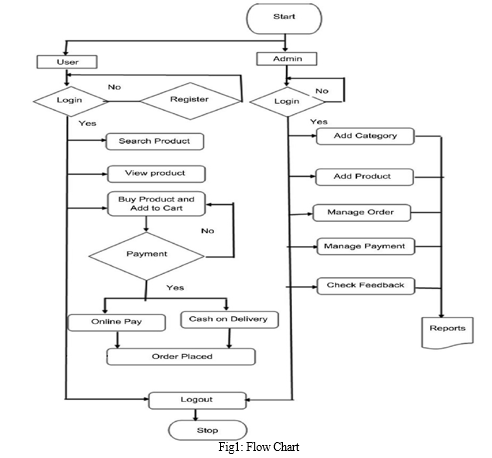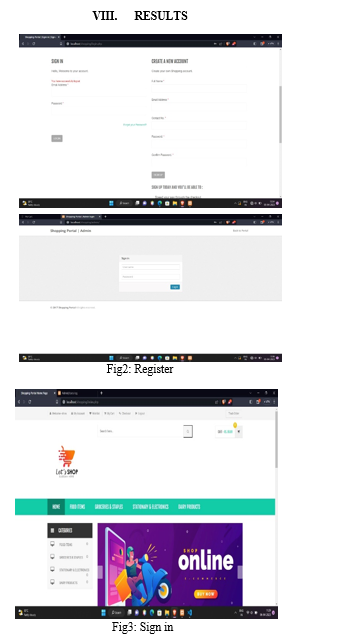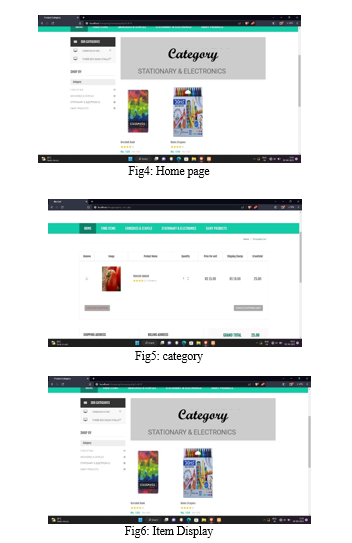Ijraset Journal For Research in Applied Science and Engineering Technology
- Home / Ijraset
- On This Page
- Abstract
- Introduction
- Conclusion
- References
- Copyright
Business Support System for Local Stores
Authors: R Shiva Prasad Reddy, B Lohitha, Raghavendra Reddy K, S Shailesh Kumar
DOI Link: https://doi.org/10.22214/ijraset.2023.51741
Certificate: View Certificate
Abstract
Business support system for local store, promotes the purchase of products that are available in local store. During the pandemic customers became more habituated towards e-commerce sites than local stores. This web application gives an opportunity to local stores that can publish and sell their products through online platform and connects the registered local store to people which contains local store details. It boosts and helps the local store to expand their distribution and also increase their sales. This web application enable connection between the people and local store in efficient manner. Motive is to inspire, encourage and enable the remaining vast majority of small business to step into the online world.
Introduction
I. INTRODUCTION
India has about 6.3 crore Micro, Small & Medium Enterprises (MSMEs) and among them only a mere 10 lakh MSMEs are running their businesses online. Small local stores are an important part of the community as they provide essential goods and services to the people living in the surrounding areas.
However, these businesses often face a number of challenges when it comes to competing with larger corporations and adapting to changing market conditions. In recent years, there has been a growing recognition of the need to support local businesses and help them thrive in an increasingly competitive marketplace.
One way to support local stores is by implementing business support systems that can help them to streamline their operations, improve their efficiency and effectiveness, and better serve their customers. These systems can include a range of tools and services, such as inventory management software, customer relationship management (CRM) systems, online marketing platforms, and financial management tools. This paper goal is to inspire, encourage and enable the remaining vast majority of small businesses to step into the online world. This will not only help the myriads of businesses expand their customer base and improve their business, but it will also help the Indian economy at large. The crowded field of competitors in B2C e-commerce indicates that achieving long-term success in Web retailing requires e-vendors to adhere to traditional economic and marketing principles and apply traditional marketing strategies.
II. LITERATURE REVIEW
The authors in [1] says that the development of an e-commerce application that allows local stores to sell their products online. The authors note that while e-commerce has become increasingly popular, many small businesses are still hesitant to adopt it due to the high cost and technical complexity of building and maintaining an e-commerce platform. The application is designed to be easy to use for both store owners and customers, with a simple interface that allows customers to browse products and make purchases, and store owners to manage their inventory and sales.
The authors tested the application with a small group of local stores and found that it was effective in increasing their sales and expanding their customer base. The application was also found to be scalable, allowing for additional stores to be added without requiring significant changes to the underlying infrastructure.
The authors in [2] says that the development of an online store platform for small and medium-sized enterprises (SMEs) to sell their products online. The authors note that many SMEs struggle to establish an online presence due to the high cost and technical complexity of developing an e-commerce platform.
To address this issue, the authors developed a low-cost and user-friendly online store platform that allows SMEs to easily create and manage their own online stores. The platform includes features such as product catalogs, shopping carts, and payment processing, and can be customized to match the branding of individual businesses. The authors tested the platform with a small group of local SMEs and found that it was effective in increasing their sales and expanding their customer base.
The platform was also found to be scalable, allowing for additional SMEs to be added without requiring significant changes to the underlying infrastructure.
The [3] paper analyzes the impact of e-commerce development on enterprises operation and management. The authors note that e-commerce has brought significant changes to traditional business models and has become a major force in shaping the global economy.
The E-commerce elements that link organizational systems have been examined and business. The authors conducted a survey of 100 enterprises in China to investigate the impact of e-commerce on their operations and management. The survey found that e-commerce had a positive impact on enterprises' sales, profitability, and customer satisfaction.
In addition, e-commerce was found to enable enterprises to expand their market reach, improve their supply chain efficiency, and enhance their competitiveness.
The authors suggest that enterprises need to address these challenges by developing appropriate security measures and legal frameworks.
The paper [4] authors describe that explores the relationship between modern logistics and e-commerce. The authors note that e-commerce has fundamentally changed the way businesses operate and that modern logistics plays a critical role in supporting e-commerce activities.
Authors found that modern logistics has become increasingly important for e-commerce businesses as it enables them to improve their supply chain efficiency, reduce costs, and enhance customer satisfaction. The paper discusses various aspects of modern logistics, including transportation, warehousing, and inventory management, and their impact on e-commerce. The authors also highlight the importance of information technology in modern logistics and how it has enabled e-commerce businesses to achieve real-time tracking and monitoring of their supply chain.
The authors [5] says that the state of e-commerce in the early 2000s and analyzes whether its growth would continue or level out. The authors note that e-commerce had experienced significant growth in the late 1990s and early 2000s but faced challenges such as security concerns, lack of trust among consumers, and regulatory issues
The paper discusses the potential factors that could impact the growth of e-commerce, including security and trust issues, regulatory challenges, and economic conditions.
The authors argue that businesses need to address these challenges to maintain consumer confidence and sustain e-commerce growth.
III. METHODOLOGY
- Conduct Market Research: The first step in developing a business support system is to conduct market research. This involves identifying the needs of local stores, understanding their pain points, and analyzing the competition. Market research can be conducted through surveys, interviews, and focus groups. The insights gained from this research will help inform the design and development of the system.
- Define System Requirements: Once the market research is complete, the next step is to define the system requirements. This involves outlining the features and functionality that the system should have to meet the needs of local stores. Requirements should be specific, measurable, achievable, relevant, and time-bound (SMART). This helps ensure that the system is designed to meet the needs of local stores effectively.
- Design the System Architecture: With the requirements defined, the next step is to design the system architecture. This involves defining the hardware and software components, system interfaces, and data flows. The system architecture should be designed to support the system requirements, and ensure that the system is scalable, reliable, and secure.
- Develop and Test the System: With the system architecture designed, the next step is to develop and test the system. This involves writing code, creating user interfaces, and integrating the various hardware and software components. Testing is a critical step in the development process and should be done rigorously to ensure that the system meets the requirements.
- Implement the System: Once the system is developed and tested, the next step is to implement it. This involves installing the hardware and software components, configuring the system, and training users. The implementation phase should be carefully planned to minimize disruption to store operations.
- Provide Ongoing Support and Maintenance: After the system is implemented, ongoing support and maintenance are essential to ensure that it continues to meet the needs of local stores.
This includes providing user support, troubleshooting system issues, and updating the system as needed.
IV. SYSTEM ARCHITECTURE

V. PROBLEM STATEMENT
To develop a web network that will be able to connect local store and public needs.
VI. OBJECTIVES
- To bridge the gap between the customer and the local Stores.
- To help customers to buy their own choice products having particular criteria from reliable and trust worthy vendors.
- To establish publishing media and distribution supporters for promoting the under-rated stores.
- To overcome the domination of branded stores and popular E-commerce influence.
VII. DESCRIPTION OF MODULES
- Inventory Management Module: This module allows the store to manage its inventory efficiently. It includes features like a product catalog, stock management, purchase orders, and reordering alerts.
- Sales Management Module: This module helps the store to manage its sales operations. It includes features like the point of sale, order management, invoicing, and payment processing.
- Customer Management Module: This module allows the store to keep track of its customers and their purchase history. It includes features like a customer database, loyalty programs, and targeted marketing campaigns.
- Reporting and Analytics Module: This module provides insights into the performance of the store. It includes features like sales reports, inventory reports, customer analytics, and trend analysis.
- Employee Management Module: This module helps the store to manage its workforce. It includes features like employee scheduling, time tracking, payroll management, and performance evaluation.
- Marketing and Promotions Module: This module helps the store to create and manage marketing campaigns and promotions. It includes features like social media marketing, email marketing, and coupon management.
- Order Fulfillment Module: This module helps the store to fulfill customer orders efficiently. It includes features like order tracking, shipping management, and returns management.
- Security and Compliance Module: This module ensures that the store is compliant with regulations and security standards. It includes features like data encryption, access control, and compliance reporting.


Conclusion
The main goal of this paper is to establish a connection between customer and local stores. It is one of the best platforms for buyer and seller to sell and buy product within a very short time and easiest way. This paper goal is to inspire, encourage and enable the remaining vast majority of small business to step into the online world. The consumer always seeks value for money to satisfy his need, also to be inspired and to have a great uplifting shopping experience. The store requires increasing profits while trying to excel in satisfying any customer requirement. The future customer will always be connected. The customer will enjoy a shopping experience, receiving personalized services leading to building loyalty and trust with the shop.
References
[1] Hossain, M. A., Hossain, M. S., Islam, M. S., & Amin, M. A. A. (2018, September). Development of an E-commerce Application for Local Stores Using on Advances in Computing, Communications, and Informatics (ICACCI) (pp. 981-985). IEEE. [2] Carvalho, M. A. de, Tonini, A. M., Frederico, G. F., & Dutra, M. G. (2016, March). Development of an online store for small and medium-sized enterprises. In 2016 International Conference on Industrial Engineering and Operations Management (IEOM) (pp. 1445-1453). IEEE. [3] D. Shanshan and Z. Lei, \"Study on Impact of e-Commerce Development on Enterprises Operation and Management “, 2010 International Conference on Management of e-Commerce and e-Government, 2010, pp. 255-258, Doi: 10.1109/ICMeCG.2010.60. [4] Zhang Lixin and Shi Faliang, \"An analysis on the relationship between modern logistics and e-commerce,\" 2008 IEEE International Conference on Service Operations and Logistics, and Informatics, 2008, pp13811384doi:10.1109/SOLI.2008.4686616. [5] Jawed Siddiqi, Babak Akghar, Carl Davies and Samir Al-Khayatt, E-Commerce: Continuous Growth or Leveling Out, Proceedings of IEEE International Conference on Information Technology: Coding and Computing, 2002, pp. 491- 496. [6] A. Garcia-Sanchez, R. Molina-Carmona, and J. M. Garcia-Garcia “A support system for small retail businesses to improve efficiency and profitability\" 2014 IEEE 14th International Conference on Ubiquitous Computing and Communications (IUCC), 2014, pp.584-589, Doi: 10.1109/PICOM 2014.109. [7] Sowmyan Raman, “E-Commerce and Globalization” -Yesterday, Today and Tomorrow, Proceedings of IEEE Engineering Management Society, 2000, pp. 249-254. [8] Daniel A. Menasci, A Reference Model for Designing an E-Commerce curriculum, IEEE Concurrency, Vol.8, No.1, 2000, pp. 82-85. [9] Raj Veeramani and Nancy Talbert, Where Are We in Global E-Commerce, IT Professional, Vol.1, No.6, 1999, pp. 46-52. [10] Louis A. Lefebvre, Lue Cassuvu and Elisabeth Lefebvre, Business-to-Business E-Commerce: A Transition Model, Proceedings of IEEE 34thAnnual Hawaii International Conference on System Sciences, 2001, pp. 2187-2196.
Copyright
Copyright © 2023 R Shiva Prasad Reddy, B Lohitha, Raghavendra Reddy K, S Shailesh Kumar. This is an open access article distributed under the Creative Commons Attribution License, which permits unrestricted use, distribution, and reproduction in any medium, provided the original work is properly cited.

Download Paper
Paper Id : IJRASET51741
Publish Date : 2023-05-07
ISSN : 2321-9653
Publisher Name : IJRASET
DOI Link : Click Here
 Submit Paper Online
Submit Paper Online

